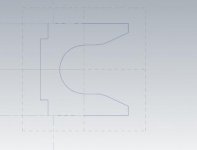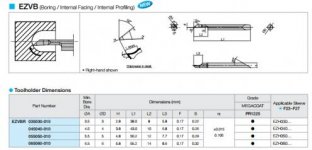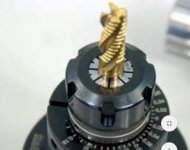quantity several hundred. The cavity terminates with a 10mm hemisphere
hello finegrain

tool 3 :
... desired radius + z>=2
... good to have : a bit of conicity + short as posible + maybe coolant through
... short straight flutes ( cheaper )
tool 2 :
... tool 3 scaled down, so to make life easier for tool 3
... longer flutes
tool 1 : normal drill, so make life easier for tool 2
tool 3 should never cut more than 0.2 - 0.5 mm
tool 3 should last for long time, delivering nice finish surface, at high specs
tool 2 is doing the dirty work

this tool may have the profile not exactly a full radius, but a bit changed, so to handle cutting forces better; it is roughing less than tool 1, but it should cost more than tool 1, so it is necessary to make it last much longer than tool 1
tools 3&2 should rotate (live holder), so to deliver a smoother cutting and avoid main spindle stress because of high rpm
it may be possible to eliminate tool 2; in this case, tool 3 will cut more, so a bit of profile deviation from the full radius may help
if tool3 is not coaxial with the spindle, or if coaxiality can not be maintained, than is no longer possible to finish the part; this makes it hard to get setup stability using only Z axis + tools with active diameter = nominal diameter; alternatives :
1) reduce tool3 diameter and :
... it should work just like that on the M axis, or
... interpolate, or
... use it as a turning tool
... use it with a 2nd tool that will finish the center, etc
2) reduce tool 3 diameter and compensate for coaxial errors using an excentrical adjustement holder inside a live holder ( attached ) :
http://www.ews-tools.de/upload/pdf/flyer/ews_flyer_flexicenter_en.pdf
EWS.Centerpoint und EWS.Flexicenter - YouTube
* that girl is the boss daughter or something, and the music ( kind of new era theme ) from the video is way too much only for this
3) turning should be considered for finishing, because turning is less coaxiality demanding ( kyocera tool attached ); however, on small tools, especially for those that must deliver bottom radius, Y excentricity may be tricky; Y excentricity fine adjustments on lathes without Y, may be an interesting discussion

but such small tools are not cheap, so Y exc. adjustemnt can wait
ps : i guess these are normal : tolerances, rugozity, control method / have a good day


 .
.
 .
.




